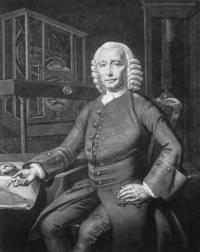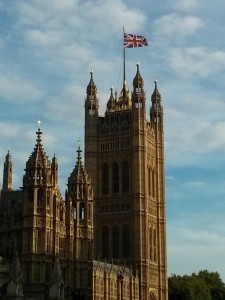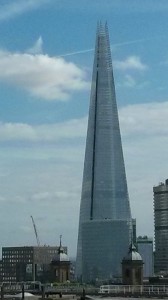When you’re facing hard problems, sometimes the best answer is to discard what you think you know to be true, and to think differently.
Three hundred years ago the Royal Navy and the British Merchant Marine were facing a very hard problem: How to determine a ship’s longitude on the high seas.
Let’s back up: If you know your latitude (north/south) and longitude (east/west), you know exactly where you are. When you’re onboard a ship out of sight of land for days or weeks, this is more than handy: It’s imperative. Latitude has always been relatively easy to determine, from the altitude of the sun at noon (with the aid of a table), but longitude was thorny. I knew a fair amount about the problem from having read the 2007 Dava Sobel book, Longitude, but it wasn’t until I was in London last week that I had the chance to visit the Royal Observatory in Greenwich and see first-hand some of the artifacts of the period. The genius it took to solve this hard problem—by thinking differently—is now blazed into my memory.
The Royal Observatory itself was founded by King Charles II in 1675 primarily to solve the longitude problem:
Whereas, in order to the finding out of the longtitude of places for perfecting navigation and astronomy, we have resolved to build a small observatory within Our Park at Greenwich…
Here’s a clear statement of the problem from the Royal Observatory’s own site:
For every 15° that one travels eastward, the local time moves one hour ahead. Similarly, travelling West, the local time moves back one hour for every 15° of longitude.
Therefore, if we know the local times at two points on Earth, we can use the difference between them to calculate how far apart those places are in longitude, east or west.
Theoretically, therefore, “all” one had to do was to provide ships at sea with clocks that could accurately tell the time at some reference point (say, Greenwich), compare it to local time, and presto. But 300 years ago, far far easier said than done.
But in 1714 Parliament upped the ante with the Longitude Act, which provided a range of prizes for what was simply called “the longitude,” scaled as follows:
- £10,000 for a method that could determine longitude within 60 nautical miles (111 km), or one degree (four minutes of time)
- £15,000 for a method that could determine longitude within 40 nautical miles (74 km), or 40′
- £20,000 for a method that could determine longitude within 30 nautical miles (56 km), or half a degree (two minutes of time), all on a voyage “…over the ocean, from Great Britain to any such Port in the West Indies as those Commisioners Choose… without losing their Longitude beyond the limits before mentioned.”
The most valuable prize was the equivalent of about $1-million today.
According to another historian of the period, no less than Isaac Newton, President of the Royal Society, testified before Parliament preparatory to the Longitude Act about the difficulty of such a timekeeping device:
“…by reason of the Motion of a Ship, the Variation of Heat and Cold, Wet and Dry, and the Difference of Gravity in Different Latitudes, such a Watch hath never been made.”
Enter John Harrison, 21 years old when the Longitude Act was passed. Harrison was born in 1693 at Foulby in Yorkshire, the eldest son of a struggling carpenter, although the family soon moved to Barrow, in Lincolnshire. John learned carpentry as a young man but by 1714 he had turned himself into a talented clock maker, constructing long-case clocks entirely from wood, which was not as odd at the time as it might strike us today. A glimpse of his later genius at discarding what everyone—including Harrison—knows to be true came when he built a “revolutionary” turret clock for the stables of the Pelham family’s Brocklesby Park: Revolutionary because it required no lubrication. 18th Century clock oils were of notoriously poor quality and the leading causes of clocks failing. But rather than trying to design a better oil, he designed a clock that didn’t need it.
In 1728, Harrison decided to enter the Longitude prize competition. Between 1730 and 1735, he built his first entry, “H1,” which was tested on a round-trip voyage from London to Lisbon in 1736, keeping time well enough to correct a misreading of the vessel’s longitude on the return voyage. But Harrison wasn’t satisfied.
He set to work on H2 in 1737, fundamentally of the same design as H1 but larger and heavier. After three years, however, he decided his initial design was intrinsically flawed in that the bar balances didn’t always counter a ship’s motion, and they would need to be circular.
H3 took Harrison 19 years to build—1740 to 1759—but as with H2 it failed to reach the requisite degree of accuracy, despite incorporating two entirely new inventions of Harrison, a bimetallic strip to counter temperature changes, and a caged roller bearing, both of which are widely used to this very day.
In 1753 (now age 60), and having reflected on his accumulated learning from H’s 1 through 3, Harrison commenced work on H4. This time he set out in an entirely different direction, discarding everything he had done before in his life. He explained his thinking succinctly to the Board of Longitude: “having good reason to think from the performance of one already executed… that [properly designed] small machines may be render’d capable of being of great service with respect to the Longitude at Sea…”
And such a different direction it was.
Rather than the large, boxlike constructions of H1—H3, H4 was what we recognize instantly today as a large pocket watch, about 12 centimeters in diameter, with a jeweled mechanism into which Harrison had put “fifty years of self-denial, unremitting toil, and ceaseless concentration.” He wrote:
“I think I may make bold to say that there is neither any other Mechanism or Mathematical thing in the World that is more beautiful or curious in texture than this my watch or Time-keeper for the Longitude.”
Now age 68, Harrison wasn’t up to accompanying H4 on a sea trial to the West Indies, so he entrusted it to his son William. It was secured on board the Deptford bound for Jamaica in a case with four locks, one key to each being given to William, Governor Lyttleton of Jamaica (taking passage on the ship), Captain Dudley Digges, and his lieutenant. All four needed to be simultaneously present with their keys to unlock the case for each winding. The ship sailed on 18 November 1761.
Nine days out, the Deptford‘s longitude, by dead reckoning, was 13 50′ W, but according to Harrison’s calculations, based on the timepiece, it was 15 19’ W – a difference of nearly 160 kilometers. Harrison told a skeptical Captain Digges that if Madeira was properly placed on the chart they should sight land the next day. Despite his reservations, Digges held to Harrison’s course. At 6 a.m. the next day, the lookout reported seeing land dead ahead. It was Porto Santo, the northeastern island of the Madeira group.
Upon landing in Jamaica on 19 January 1762, H4 was found to be only 5.1 seconds slow, the equivalent of an error in longitude of 1.25’—1.25 nautical miles, or 2.3 kilometers. H4’s performance resoundingly qualified Harrison to win the £20,000 prize. (One degree of longitude varies in size depending on how close to or far from the equator one is, but at the equator it’s approximately 69 miles [the same size as the invariant size of one degree of latitude]; a minute is approximately 1.15 miles and a second 0.02 miles, or about 100 feet.)
Here, alas, the story descends into the petty disputatiousness the Board of Longitude adopted, requiring additional condition upon additional condition (another sea trial, full disclosure of H4’s workings to a special committee, and Harrison’s making four copies of H4, all to be handed over to the Board), and even then they withheld the full prize. The final insult came when they demanded Harrison make two successor time-keepers to H4 (which became known as H5 and K1—the “K” referring to Larcum Kendall, a leading watchmaker whom Harrison recruited for assistance), but meanwhile the Board took the original away to the Royal Observatory “for testing.”
Finally, Harrison, age 79, appealed to the highest authority in Britain, King George III, who summoned him for a personal audience at Windsor Palace.
“I cannot help thinking,” he wrote to the board, “but I am extremely ill used by gentlemen who I might have expected different treatment from… I hope I am the first, and for my country’s sake, shall be the last that suffers from pinning my faith on an English Act of Parliament.”
George III had an informed and sympathetic interest in technology. He had been so impressed by the accounts of the Tartar’s voyage that he had granted Harrison and his son an audience at Windsor. And so Harrison now asked for another audience in which to state his case, the case for his Number Four. The audience was granted, and upon hearing the story, George III lost his patience. “You have been cruelly wronged. By God, Harrison, I’ll see you righted,” the king declared, and so he did.
Harrison received the balance of the £20,000 in 1773 and died at his house in Red Lion Square in London on March 24, 1776, age 83. The BBC’s 2002 public poll of the 100 Greatest Britons saw Harrison place 39th.
Here we have the story of wrestling with a hard problem. In this case, it was essentially one individual wrestling with the problem for his entire lifetime, starting from the basis of a craft he learned at his father’s feet. It’s almost difficult to imagine anyone at the time who could have been better versed in the art, the craft, and the technique of carpentry and by extension of mechanics, than John Harrison.
Yet he realized the solution to his own self-imposed Hard Problem was to abandon the path he’d been following for nearly 40 years (H1—H3) and to embrace a new direction entirely.
We, as a profession and as an industry, are deeply in need of taking inspiration from stories such as Harrison’s. Confronted today by Hard Problems (“the Longitude” was an exceedingly hard problem in its day), we seem to resort to the H1’s, H2’s, and H3’s of our world, doing what’s familiar and comfortable, modest extensions of and marginal improvements upon what we know how to do in our sleep. Our craftsmanship may be exquisite, but on a more profound level we’re answering the wrong question. We are not truly wrestling with the Hard Problem.
Symbolically, we are architects designing a new version of Parliament, not envisioning a Shard.
We need leaders with the creative vision, driven by determination, that Harrison displayed. Otherwise we are doomed to build more H1-3’s, brilliantly executed, fundamentally flawed, machines.









